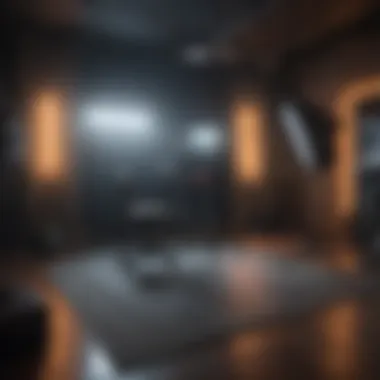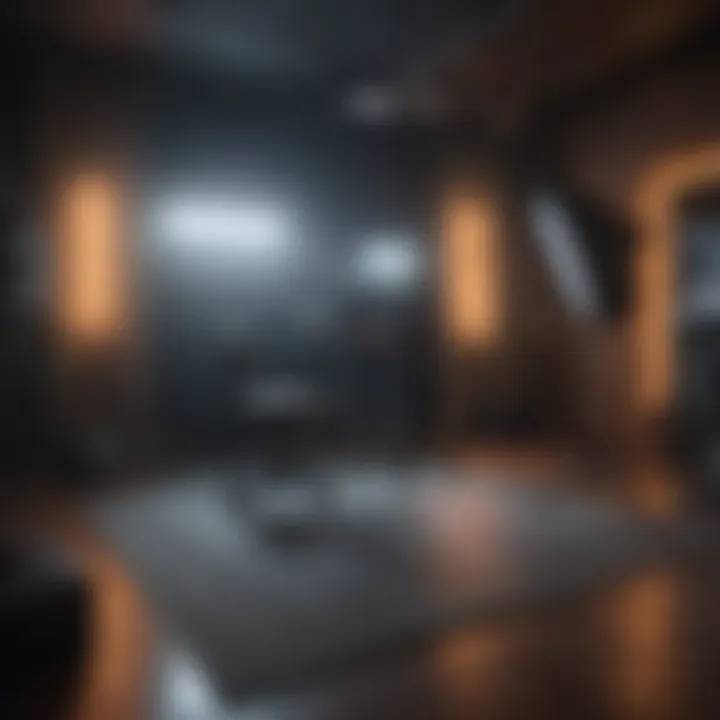Exploring Long-Distance Music Collaboration


Intro
In recent years, the music industry has witnessed a significant transformation. Technology is reshaping how artists collaborate and create music. The concept of long-distance music collaboration has become increasingly popular. Musicians from different regions or even countries can now connect to produce music together. This article delves into the mechanisms behind this development. It explores what tools are available and the challenges that arise during remote collaborations. Additionally, we will examine successful case studies where artists have leveraged distances to create innovative works.
Techniques and Tips
Skill Development
Long-distance collaboration requires distinct skills from musicians. First, artists need to be proficient in their instruments or vocal techniques. They should also develop strong digital communication skills. Understanding music production software is essential too. Skill-building can occur through online courses or video tutorials. Platforms like YouTube or Skillshare can provide resources for self-study.
Practical Techniques
When collaborating remotely, there are several practical techniques to enhance productivity. Recording in high-quality settings is crucial. Use software such as Ableton Live or Logic Pro to capture your sound effectively. Clear communication is also vital; artists should establish regular check-ins using tools like Zoom or Skype. Share files efficiently with cloud services like Dropbox or Google Drive. This ensures everyone has access to the necessary materials in real time.
Common Mistakes to Avoid
Artists new to long-distance collaboration often face hurdles. One major mistake is not setting clear expectations for the project. Miscommunication can lead to frustration. Another pitfall is neglecting to review each other's contributions thoroughly. Collaboration thrives on constructive feedback. Moreover, some artists may overlook the technical aspects of music production, resulting in poor-quality recordings. Understanding the importance of audio quality is critical.
Gear and Equipment
Essential Gear for Beginners
For those just starting with long-distance collaboration, essential gear includes a decent microphone, headphones, and a reliable audio interface. A microphone that captures sound clearly enhances vocal recordings. Quality headphones help artists listen to nuanced details during production. Audio interfaces bridge the gap between instruments and recording software.
Latest Innovations and Trends
The music tech industry constantly evolves, introducing new tools for artists. Remote collaboration now benefits from AI-driven software, such as LANDR, which can master tracks automatically. Online platforms such as Splice offer vast libraries of samples and loops. Musicians can collaborate on projects with flexible workflows, creating innovative tracks.
Reviews and Comparisons
When selecting music gear, conducting thorough research is essential. For microphones, consider the Shure SM7B for vocals or the Audio-Technica AT2020 for versatility. Headphone options like Sony WH-1000XM4 provide great sound quality for monitoring. Reading user reviews and comparisons on platforms like Reddit helps make informed decisions.
Challenges of Long-Distance Collaboration
Long-distance collaboration presents unique challenges. Time zone differences can make scheduling tough. Technology may fail; poor internet connection or software issues can disrupt workflow. Artists may also struggle with maintaining creativity over distance. These hurdles require patience and adaptability for successful outcomes.
Ending
The rise of long-distance music collaboration marks a significant shift in the creative landscape. By implementing effective techniques and utilizing essential gear, artists can transcend geographical barriers. The journey may involve challenges, but overcoming them can lead to extraordinary outcomes. With the right tools and mindset, musicians can explore new horizons and redefine their artistic expressions.
Prelims to Long-Distance Music Collaboration
Long-distance music collaboration emerges as a prominent topic in today’s music landscape, influenced by technological progress and evolving artistic practices. It enables artists from various geographical locations to come together and create music despite the miles that separate them. This collaboration expands opportunities for creativity, allowing musicians to blend their unique influences and styles into a cohesive piece.
Definition and Context
Long-distance music collaboration can be defined as the process where musicians work together to produce music remotely. With the rise of the internet, this form of collaboration has found its knees firmly planted in the modern music industry, allowing for easier communication and exchange. Additionally, it fosters a global connection among artists who might never meet face-to-face. In this context, collaboration could take several forms, from co-writing songs over video calls to sharing tracks on platforms like Soundtrap and BandLab.
Historical Overview
Historically, long-distance collaboration was limited by the physical constraints of travel and costly communication methods. Musicians typically worked in the same location, recording in studios that required their presence. However, as technology evolved, particularly with the introduction of digital audio workstations, artists began experimenting with remote collaboration. Notable examples include the innovative collaborations of the 1980s and 1990s, when musicians started to leverage the internet, opening doors to a more flexible model of music creation. Over time, platforms for sharing music and ideas matured, making long-distance collaboration not just feasible but increasingly popular in today’s music sector.
"The internet has revolutionized how musicians create music together, bridging gaps that were once insurmountable."
This historical progression highlights how today's collaboration can now incorporate diverse influences that enhance the depth and quality of the music produced. Thus, understanding long-distance music collaboration means recognizing the continuous transformation of the music industry and its ever-changing dynamics.


Technological Innovations Enabling Collaboration
The importance of technological innovations in music collaboration cannot be overstated. With artists now able to connect across vast distances, technology acts as the bridge that facilitates creativity and communication. This evolution transforms how music is produced, composed, and shared. The right tools and platforms enable artists to collaborate seamlessly, blending different influences and styles in ways that were previously challenging.
Digital Audio Workstations (DAWs)
Digital Audio Workstations, or DAWs, are essential in the contemporary music creation process. They provide a comprehensive platform where artists can record, edit, and produce music in a powerful environment. Popular options like Ableton Live, Logic Pro, and Pro Tools allow for intricate sound design and arrange multiple tracks with ease.
- Functionality: DAWs support various instruments and plugins, helping musicians to construct complex compositions.
- Remote Access: Many DAWs now offer cloud functionalities, allowing collaborative projects to be accessed from different locations.
- User Friendliness: The range of tutorials and community support available means that artists of all skill levels can learn how to use them effectively.
The accessibility of DAWs democratizes music production, enabling more artists to participate in long-distance collaborations.
Cloud-Based Collaboration Tools
Cloud-based collaboration tools have revolutionized the way musicians can work together. Platforms like Splice and Soundtrap facilitate sharing and editing music projects online. These tools provide an environment where artists can upload their work, make changes, and provide feedback, all in real-time.
- Storage Solutions: Artists can save their projects in a central location, minimizing issues related to file versioning and loss.
- Collaborative Features: Tools designed for collaboration allow users to comment on specific sections of a track, ensuring that feedback is clear and directly related to the work.
- Accessibility: The ability to access projects from any device encourages spontaneous collaboration, no matter where team members are based.
The implications of these tools extend beyond mere convenience. They allow for more extensive networks of collaboration, inviting diverse influences into the creative process.
Real-Time Communication Technologies
Real-time communication technologies like Zoom and Discord have become integral to long-distance music collaboration. These platforms facilitate live discussions, which can lead to immediate feedback and enhanced creative synergy.
- Face-to-Face Interaction: Using video calls helps personalize the remote collaboration experience, making it more engaging and ensuring clear communication.
- Instant Feedback: Artists can share ideas and make decisions quickly, enhancing productivity.
- Community Building: These tools create a sense of belonging among collaborators, even if they are thousands of miles apart.
As musicians continue to explore the boundaries of remote collaboration, the role of real-time communication will likely grow, fostering deeper connections and collaboration across disciplines.
"Technological tools have dramatically redefined the landscape of music creation, empowering artists to produce and collaborate beyond geographical limits."
Benefits of Long-Distance Collaboration
Long-distance music collaboration is becoming more than a trend; it is reshaping how artists create and share their work. As the barriers of geographical distance diminish, musicians find themselves in a unique position to harness various advantages that long-distance collaboration brings to the table. This section outlines some of the key benefits, emphasizing how these aspects contribute to the growing appeal of remote artistry.
Access to Diverse Influences and Styles
One of the most significant advantages of long-distance collaboration is the wide spectrum of influences and styles that artists can access. Geographical distance no longer limits musicians; they can now connect with peers worldwide. This access opens channels for incorporating different music styles into one's work, creating a rich tapestry of sound that may not have been possible otherwise.
For example, an artist based in New York could easily collaborate with a musician from Tokyo. The fusion of jazz and traditional Japanese music can produce unique and innovative works that reflect a global perspective. Here, cultural exchange is not just an ideal; it is a reality powered by technology. This variation enriches the creative process and promotes artistic growth.
Flexibility in Collaboration Structures
The flexibility that long-distance collaborations offer cannot be overlooked. Artists can choose when and how they want to work together, accommodating their individual schedules and preferences. Musicians may find it easier to set up a session in their own studio when inspiration strikes, instead of waiting for a physical meeting, which can be hindered by logistical issues.
Different collaboration structures can suit different projects. Whether it involves file sharing, real-time jamming through online platforms, or sending tracks back and forth for revisions, the choices are vast. This adaptability often leads to more satisfying outcomes for all parties involved, as it caters to their personal working styles and creative rhythms.
Cost-Effectiveness
Engaging in long-distance music collaboration can also be cost-effective. Traveling expenses associated with in-person meetings can add up quickly, especially for independent artists working with tight budgets. Remote collaboration minimizes these costs effectively. Artists can save money on travel, accommodation, and studio rentals by collaborating from their respective locations.
Additionally, many online tools provide affordable or even free options for sharing and editing music. Platforms such as Soundtrap, Splice, or Audiomack allow artists to exchange ideas and refine their tracks without significant financial investment. This financial aspect makes it simpler for emerging artists to engage in collaborations that might have once seemed unattainable due to costs.
In summary, long-distance collaboration expands musical horizons, offering artists rich influences, flexible working structures, and cost-effective solutions. These elements contribute to an environment where creativity can flourish, encouraging artists to explore and innovate beyond their immediate spheres.
Challenges of Remote Collaboration


As artists venture into the realm of long-distance collaboration, they often encounter a series of challenges that can impede the creative process. Understanding these obstacles is vital for any musician aiming to maximize the benefits of remote interactions. This section discusses key elements, including communication barriers, time zone differences, and technical issues, which are crucial when collaborating from afar. Recognizing these challenges allows musicians to develop strategies that can enhance their workflow, maintain artistic vision, and foster successful collaborations.
Communication Barriers
In any collaboration, clear communication is essential. However, in a remote setup, this becomes even more critical. Misinterpretations can arise easily due to the lack of physical presence. Critical nuances in an artist's vision may get lost in translation through text-based messages or audio files.
- Non-verbal cues are missing: Body language and facial expressions convey significant information. In a remote collaboration, these cues are absent, which can lead to misunderstandings.
- Different communication styles: Collaborators may have distinct styles of communication. Some might prefer concise messages while others value detailed feedback. This inconsistency can cause frustration.
To mitigate these barriers, musicians can adopt tools like video conferencing, which can help facilitate a more natural flow of communication. Utilizing platforms such as Zoom or Skype can establish a more personal connection, allowing collaborators to share ideas and refine concepts in real time.
Time Zone Differences
Collaborating across geographic boundaries often means working with individuals in different time zones. This can lead to challenges in scheduling sessions and feedback loops, causing delays in the creative process. For instance, if an artist in New York is working with someone in Tokyo, they will likely struggle to find a time when both can be online together.
- Delayed responses: Time zone differences can result in prolonged periods of waiting for responses. Decisions may take much longer, leading to frustration.
- Inconsistent work hours: Each artist may have unique routines that do not align easily. This discord can cause clashes in workflow and motivation.
Setting a shared schedule, including agreed-upon hours for communication, can enhance productivity. Tools like Google Calendar can help in proposing and managing availability and deadlines.
Technical Issues and Solutions
Technical problems often arise in remote collaborations. These issues can disrupt workflow, affect morale, and even strain relationships among collaborators. It is important to address these obstacles effectively.
- Internet reliability: A stable internet connection is crucial for smooth communication and data transfer. Poor connection can lead to dropped calls and frustration during important discussions.
- Software compatibility: Different collaborators may use various software tools, which can complicate the merging of audio files or project files.
Fortunately, many of these issues can be managed by adopting reliable technology solutions. Using well-known platforms like Avid Pro Tools or Logic Pro can assure compatibility with most collaborators. Moreover, artists can prepare backup plans, such as recording ideas locally in case of connectivity issues.
"The key to overcoming technical challenges lies in preparation and flexibility."
By anticipating potential hurdles, musicians can enhance their workflow and focus more on creativity.
Case Studies in Long-Distance Collaboration
Case studies provide a practical lens through which we can evaluate the dynamics and impact of long-distance music collaboration. By examining actual instances of artists working together remotely, we gather valuable insights into both successes and challenges inherent in this collaborative process. These real-world examples demonstrate how technology, creativity, and independent collaboration can intersect to produce remarkable results that transcend geographical limitations.
In this section, we explore two key areas: famous collaborations and their outcomes, and emerging artists who are leveraging remote collaboration to create innovative projects.
Famous Collaborations and Outcomes
Several high-profile collaborations stand out as benchmarks for successful long-distance partnerships. One notable example is the collaboration between Gorillaz and various artists around the world. Gorillaz has a history of producing music with artists remotely, allowing for a diverse range of influences to shape its sound. This collaboration model has led to the creation of chart-topping tracks featuring contributions from artists like Snoop Dogg, Janelle Monáe and Elton John. The outcome often blends distinct musical styles, resulting in a unique audio experience that reflects the artists' varied backgrounds.
Another significant example is the hit song "Despacito," which saw Puerto Rican artist Luis Fonsi collaborate with Daddy Yankee and later Justin Bieber. Although they were in different locations, the seamless integration of their various styles and perspectives resulted in a track that achieved global popularity. The rise of this song emphasizes how long-distance collaborations can lead to massive success and reach, benefiting from the unique qualities each artist brings to the table.
"Collaborating from different locations can greatly enhance the creative process, allowing artists to merge diverse musical elements into a cohesive piece."
The outcomes of these projects reveal not just artistic achievement but also their commercial viability. By reaching wider audiences and engaging fans from different backgrounds, the artists benefited from increased visibility and marketability.
Emerging Artists and New Projects
The rise of long-distance music collaboration is not only a phenomenon for established artists but also for emerging musicians. Many new talents leverage digital platforms to collaborate with peers across the globe. A prime example is the collective project called "Socially Distanced Compositions," where musicians from varying genres come together during the pandemic to record and share music remotely.
Moreover, platforms like Splice and Soundtrap have empowered independent artists to produce and collaborate with others without the need for physical presence. Artists can connect with one another based on shared interests or complementary sounds, leading to the creation of innovative works that might not have happened in traditional studio settings.
Consider the project "K-Pop Star," where unknown singers collaborate with renowned K-Pop producers from different countries. This symbiosis validates the efficacy of remote collaboration and showcases how it can open doors for newcomers in an otherwise competitive industry.
As these examples illustrate, the collaborative environment created through technology is an incubator for creativity. It allows artists to form connections, share knowledge, and explore new avenues that wouldn't otherwise be available.


By studying these collaborations across different artistic backgrounds and levels of experience, musicians can gain insights into successfully navigating their creative partnerships in innovative and effective ways.
Creating a Productive Remote Environment
In the realm of long-distance music collaboration, creating a productive remote environment is essential for success. The dynamics of working with artists scattered across different locations require specific strategies to maximize creativity and efficiency. By focusing on the workspace setup and the establishment of clear objectives, musicians can facilitate a seamless collaboration process.
Setting Up an Effective Workspace
An effective workspace is foundational for successful long-distance collaboration in music. Artists must consider their physical environment as well as the technological tools at their disposal. Here are key elements to focus on when setting up a workspace:
- Quiet Environment: Noise distractions can severely disrupt the creative flow. Select a quiet space dedicated to music production, free from interruptions.
- Essential Equipment: Having the right equipment is crucial. This includes a reliable computer, quality headphones, and a professional microphone. The investment in good tools can enhance the overall sound quality matching that of in-person collaboration.
- Software Setup: Utilizing advanced Digital Audio Workstations (DAWs) is important for tracking, editing, and mixing. Ensure that all collaborators use compatible software to avoid technical disruptions. Consider using collaboration-friendly software like Ableton Live or Logic Pro.
- Aesthetic Arrangement: An organized and aesthetically pleasing workspace can stimulate creativity. Natural light, inspiring decor, or even a plant can create a conducive atmosphere for work.
Establishing Clear Objectives and Timelines
Success in remote collaboration hinges on clear objectives and timelines. When artists set specific goals and adhere to schedules, they can ensure a smooth workflow while respecting each other's time. Here are some considerations:
- Define Project Goals: Each collaboration should start with a clear understanding of the artistic vision. What does each artist want to achieve? This alignment helps steer the project in the right direction.
- Create a Timeline: Establish a realistic timeline for project milestones. This can help all members stay accountable and track progress, making it easier to meet deadlines.
- Regular Check-Ins: Schedule regular meetings or updates to review progress. This can foster a sense of teamwork despite geographical distances.
- Adjust as Needed: Flexibility is important. If one aspect of the project takes longer than expected, be prepared to reassess timelines and objectives, ensuring that the collaboration remains productive.
"The essence of a productive remote environment lies in well-defined goals and a well-equipped workspace. It transforms what could be a logistical headache into a smooth and enjoyable creative process."
In summary, creating a productive remote environment is vital for artists collaborating from different locations. By investing time in setting up an effective workspace and establishing clear objectives and timelines, musicians can enhance their collaborative creativity and productivity.
The Future of Long-Distance Musical Partnerships
The future of long-distance musical partnerships is promising. As artists increasingly adopt remote collaboration, they tap into a wider range of creative possibilities. This trend not only allows musicians to expand their networks but also fosters innovative ways of producing music. Collaboration across distances breaks geographical limitations. It encourages diverse influences and styles to merge, creating new musical genres and sounds.
Trends Shaping the Industry
Several critical trends are defining the future of long-distance music collaboration.
- Increased Use of Technology: Digital platforms and applications are becoming more sophisticated. They offer features that enhance collaboration, such as integrated video communication, real-time recording, and sharing tools. Programs like Ableton Live, Pro Tools, and Logic Pro are continuously evolving to meet artists' needs.
- Professional Networking: Social media platforms like Facebook and Reddit provide musicians an avenue to connect with potential collaborators. As artists share their work online, they find peers who can contribute unique perspectives.
- Crowdsourcing and Open Collaboration: More artists are turning to the crowd for contributions. Platforms that facilitate collaborative projects engage listeners directly in the creative process. This democratizes music creation and gives fans a stake in the product.
- Focus on Mental Well-Being: There is a growing recognition of the mental health benefits of collaboration. Creating music remotely can lead to improved mental well-being for artists, allowing them to engage creatively without the pressures of traditional studio environments.
Potential for Innovation in Music Creation
Long-distance musical partnerships also pave the way for significant innovation in sound and technique.
- Blending of Cultures: With artists from different backgrounds collaborating, there is an influx of diverse cultural influences. This cross-pollination can lead to entirely new genres.
- Access to Expert Talents: Remote collaboration allows musicians to work with top talents from around the globe. An artist in London can seamlessly partner with a producer in Los Angeles. This access drives innovation as artists incorporate diverse skills and expertise.
- Experimentation with New Sounds: Collaborators can experiment with different genres, tools, and techniques that might not be readily available in their local scenes. This fosters a spirit of experimentation that can lead to groundbreaking music.
- Environmental Consciousness: As artists recognize the carbon footprint of touring and large studio sessions, working remotely appears more sustainable. The drive toward environmentally conscious music production can influence future collaborations.
The ability for artists to collaborate across great distances creates opportunities for inventive music creation and a resurgence of interest in diverse musical forms.
Epilogue: Embracing New Horizons
The exploration of long-distance music collaboration has significantly opened new avenues for artists in today’s digital landscape. As musicians increasingly leverage technological advancements, it becomes clear how essential it is to embrace innovative methods for music creation. This final section emphasizes the transformative potential of long-distance collaboration, bridging the geographical gaps that once limited creative partnerships.
Summary of Key Insights
Long-distance collaboration fosters a diverse range of influences. Artists can connect with talents worldwide, integrating various musical styles that enrich their work. This collaboration not only expands individual artistry but also elevates the quality of music produced. Moreover, the flexibility afforded by digital tools allows creators to manage their time and resources more effectively. Remote collaboration platforms provide seamless workflows, enabling projects to adapt without the constraints of physical presence.
Some of the key insights include:
- Technological Integration: Digital audio workstations and cloud-based tools have revolutionized music creation, proving crucial for remote artists.
- Cost-Effectiveness: The reduction in travel and studio expenses allows artists to invest resources in other areas of their projects.
- Creative Freedom: With no geographical boundaries, artists explore new partnerships that they might not have considered in traditional settings.
"The canvas of music creation is now limitless, encouraging artists to think beyond their usual borders."
Encouragement for Musicians to Explore Remote Collaboration
The landscape of music is continually evolving, inviting artists to step outside their comfort zones. The potential for growth through long-distance collaboration is notable, and musicians are encouraged to pursue these opportunities. Engaging with others remotely fosters not only skill development but also the chance to discover unique creative avenues.
Musicians should consider the following when exploring remote collaboration:
- Reach Out: Identify artists whose work inspires you and initiate contact. Building networks is essential in today's interconnected world.
- Utilize Tools: Familiarize yourself with the various platforms available, such as Splice, Soundtrap, or even common video conferencing software like Zoom. This understanding is integral to successful collaboration.
- Set Clear Goals: Establish what you wish to achieve with your partner. Clarity in objectives can help navigate the logistical challenges that may arise.







